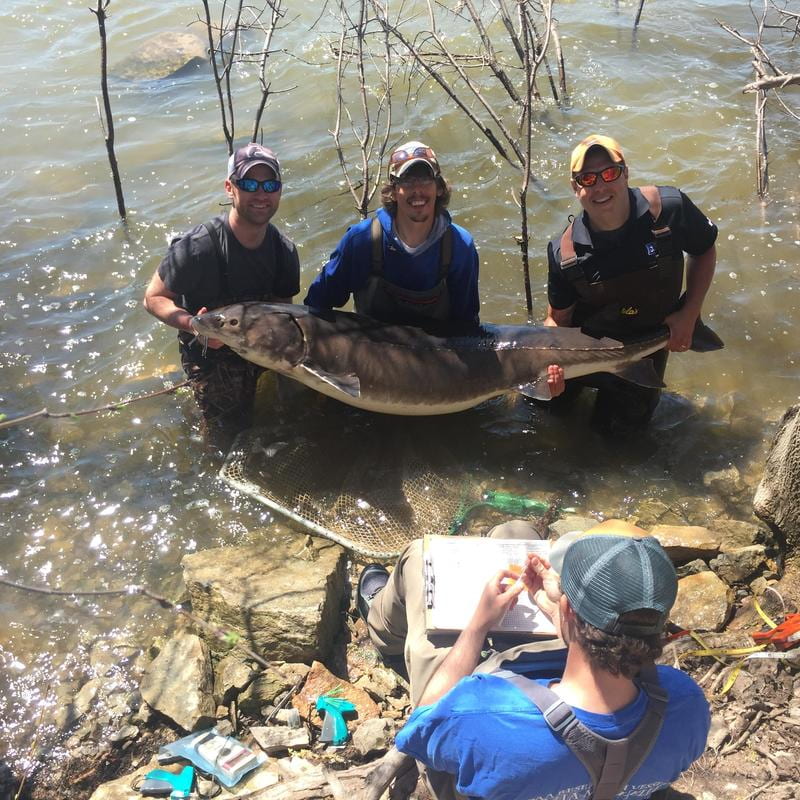Fish tales: UW-Green Bay’s Prof. Patrick Forsythe has long loved one of Wisconsin’s most revered fish species

UW-Green Bay Scientist studies prehistoric sturgeon
Studying one of Wisconsin’s most revered fish species has been a love of University of Wisconsin-Green Bay’s Patrick Forsythe since childhood, but now he gets to study whether or not efforts to save the fish are working.
Forsythe, an associate professor of biology, along with the Aquatic Ecology and Fisheries Laboratory, received $300,000 from the Great Lakes Fish and Wildlife Restoration Act and WE Energies Mitigation and Enhancement fund to research whether or not lake sturgeon in the Upper Menominee River are passing through fish passageways which are set up to help them migrate to their ancestral spawning grounds.
Knowing whether or not revered legends are migrating back and forth is important, Forsythe said, not only for the fish species health, but to see whether or not the efforts to bring the giant species back have been successful.
The problem, he said, was the dam system. Built in the early 1900s, the five dams along the Menominee River were originally put in to assist with the logging operations in the area. But as time passed, the dams were converted to hydro-electric dams to help fuel the area through electricity.
In time, however, the dams prevented the sturgeon from getting back and forth from their spawning grounds at Sturgeon Falls, WI to the big water of Lake Michigan that they like so much. Like salmon, Forsythe said, the fish need to return to their spawning grounds on the rocky river beds of the Menominee River yearly. Unlike salmon though, sturgeon aren’t quite as athletic. (Lake sturgeon caught today weigh between 30-100 pounds and grow to 3-7 feet in length. Females live 80-150 years.) While some do make it back and forth, many can’t.
Forsythe said the dams, and other human elements, had a dramatic impact on the fish’s population. He estimates the sturgeon population is 1 to 2 percent of its historic abundance.
So, through a cooperative effort of federal, state and local government agencies, electric companies and others, a fish passage was built. On one side, a fish elevator starts the sturgeon on their trip upstream. On the other, a waterslide takes them downstream.
On the upstream trip fish are taken by elevator to a research area where researchers check on their health, do an ultrasound and take a small clipping of their fins for DNA analysis, he said. Then the fish are trucked to the lake and released.
Now, it’s up to Forsythe to make sure the fish passage is working and that fish that have passed through the passage are returning to their ancestral spawning grounds to find love among the river rocks.
“Within the last 3 to 4 years they’ve really been making an effort to pass quite a few fish on an annual basis,” he said. “The first step was to figure out if those fish would just fall right back down through the dams or would they go upstream. And some fish do just come back through the dams after they’ve been transported, but a large proportion of them were going upstream.”
Now, Forsythe and his team of will be determining whether or not the young fish are the result of fish that stayed in the river, fish that moved through the fish passage, or fish that stayed in the river mating with a fish that went through the passage.
Having caught some larvae, his research team will use their DNA to see who their parents are. Extracting the genetic material and processing should happen later this year, he said.
From there, scientists and researchers will be able to use the data Forsythe’s project to make future decisions. Data will show which adult fish were most successful at spawning and what characteristics they had, so that wildlife management will know how many fish to pass through the passage each year, as well as what characteristics in those fish will give a better chance of success, for example.
The project is not only important to see whether or not the program is working, and to determine how to manage the fish passage in the future, it’s important for the people of Wisconsin, as well, he said.
“You know, they surgeon are highly revered in the Great Lakes. They call them the King of the Fish,” Forsythe said. “Tribes used to sustain themselves based on the surgeon harvest. Actually, Indian tribes locally, they probably knew more about surgeon than what we do because their migratory behavior was tied to the sturgeon migrations as well.
“It’s really a cool fish. And I think they just got hammered by over exploitation and river pollution. They’ve seen a resurgence recently, and I think people just want to see that and see them come back,” he continued. “You know this is just a really cool prehistoric animal.”
By freelance writer Liz Carey.





